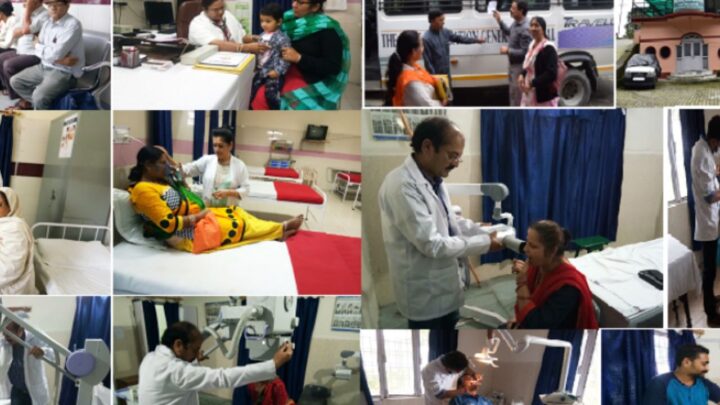Lansdowne Cantonment – Lansdowne Cantonment, a serene and historic military station nestled in the hills of Uttarakhand, is not just known for its scenic beauty and regimental heritage, but also for its effective civic management under the Cantonment Board Lansdowne (CBL). The Board has played a pivotal role in maintaining high standards of public health, sanitation, and infrastructure regulation. As a Class III Cantonment, Lansdowne has developed structured procedures and systems to ensure orderly urban governance for both military and civilian residents. This article explores how public health services, sanitation systems, and building regulations have been implemented and managed over time in Lansdowne Cantonment to maintain its charm and livability.
Public Health Services in Lansdowne Cantonment
The Cantonment Board Lansdowne has consistently prioritized health facilities for its residents, including both defense personnel and civilians. The health services are designed to address the daily medical needs, disease prevention, and emergency response.
Key Public Health Features
- Cantonment General Hospital (CGH): Equipped with doctors, nurses, and diagnostic tools to handle general outpatient care and minor emergencies.
- Regular Health Camps: Free medical check-ups, vaccination drives, and health awareness programs are held frequently.
- Vector Control Measures: The Board actively conducts fogging, anti-larval operations, and awareness campaigns to curb mosquito-borne diseases.
- Health Surveillance: Timely surveillance for diseases like dengue, malaria, and COVID-19 is maintained.
- Pharmacy Services: Essential medicines are distributed at subsidized rates to entitled categories.

Lansdowne Cantonment
Public Health Staff Structure
| Role | Count | Responsibilities |
|---|---|---|
| Medical Officer | 1 | Overall management of health services |
| Compounder/Nurse | 2 | Patient care, dressing, and injections |
| Health Inspector | 1 | Supervision of sanitation and inspection |
| Ward Boy/Support Staff | 3 | Assisting patients and hospital cleaning |
Sanitation and Waste Management in Lansdowne
Sanitation is a cornerstone of Lansdowne’s civic administration. The cantonment area remains one of the cleanest in India due to disciplined planning and daily monitoring.
Sanitation Measures Implemented
- Door-to-Door Waste Collection: Daily garbage collection is carried out using tricycles and tippers.
- Segregation at Source: Awareness campaigns promote separating dry and wet waste at the household level.
- Composting Units: Organic waste is processed at community composting plants.
- Drain Cleaning and Maintenance: Open and closed drainage systems are regularly cleaned to prevent blockages.
- Public Toilets: Well-maintained public toilets are available across the cantonment area.
- Anti-Littering Drives: Citizens are educated through posters and notices; fines are imposed on violators.
Monthly Sanitation Statistics (Sample)
| Activity | Monthly Count | Remarks |
|---|---|---|
| Households Covered | 600+ | 100% coverage |
| Daily Waste Collected | 1.2 tons | Segregated at the source |
| Compost Generated | 300 kg | Used in parks and gardens |
| Drainage Cleaning Drives | 10+ | Prevents monsoon waterlogging |
| Anti-Plastic Campaigns | 2/month | Focus on reducing single-use |
Building Approvals and Land Use Management
The Cantonment Board regulates all construction activities to maintain uniformity and safety within its jurisdiction. Building approvals are granted after technical scrutiny, ensuring that structures align with by-laws and do not hinder civic amenities or defense interests.
Process for Building Approvals
- Submission of Plan: The applicant submits a detailed architectural plan to the Board Office.
- Site Inspection: A physical inspection is carried out by the Engineering staff.
- Scrutiny Against Bye-Laws: Plans are checked against Building Bye-laws, 2020.
- Approval by CEO: Once all parameters are met, approval is granted by the Chief Executive Officer.
- Monitoring During Construction: Regular site visits ensure compliance.
Common Approval Parameters
| Parameter | Criteria |
|---|---|
| Setback Requirement | 3–5 meters as per road width |
| Floor Area Ratio (FAR) | 1.25 for residential plots |
| Building Height Limit | 10–12 meters max |
| Parking Provision | 1 car per 100 sq. m. |
| Rainwater Harvesting | Mandatory for new buildings |
| Structural Safety Certificate | Required for all buildings |

Digital Initiatives and Citizen Services
To improve transparency and convenience, the Cantonment Board Lansdowne has introduced digital services through the e-Chhawani portal.
Key Digital Features
- Online Building Plan Submission: Citizens can upload plans and track approval status online.
- Grievance Redressal Portal: Public grievances on health, sanitation, water supply, etc., can be lodged and resolved digitally.
- Sanitation Monitoring App: Supervisors upload pictures of cleaned areas and collection reports in real-time.
- SMS Alerts: Health check-up schedules, water supply notices, and garbage collection changes are sent via SMS.
Environmental and Community Efforts
Lansdowne’s administration actively involves the local community in public health and environmental efforts. Schools, religious institutions, and market associations are encouraged to participate.
Notable Community Programs
- “Swachh Cantonment” Drives: Mass participation in cleaning neighborhoods and public parks.
- Tree Plantation: Joint ventures with schools to plant saplings and promote greenery.
- Eco-Friendly Market Practices: Vendors encouraged to avoid plastic and maintain hygiene standards.
- Rainwater Conservation Projects: Local awareness about sustainable water use.
Challenges and Future Plans
Despite being well-managed, Lansdowne faces challenges like resource constraints, hilly terrain logistics, and migration pressure.
Future Initiatives
- Introduction of electric garbage collection vehicles
- Expansion of solar-powered street lighting
- GIS mapping for improved land and building data accuracy
- Telemedicine services from Cantonment General Hospital
- Smart drainage systems to detect blockages automatically
Lansdowne Cantonment serves as a model for efficient civic administration in small hill-town regions. Its commitment to cleanliness, healthcare, digital transparency, and regulated infrastructure growth reflects a perfect blend of tradition and modern governance. The efforts of the Cantonment Board, along with local participation, have kept Lansdowne not only clean and green but also highly livable. With upcoming smart initiatives, Lansdowne is set to further raise its standards as a disciplined and sustainable civic ecosystem.
FAQs
- Who manages public health and sanitation in Lansdowne Cantonment?
The Cantonment Board Lansdowne (CBL) is responsible for managing public health services, sanitation, and building regulations in the area. - How can residents get building plan approval in Lansdowne Cantonment?
Residents must submit architectural plans to the Cantonment Board, which are reviewed and approved based on existing building bye-laws and site inspections. - Are there digital services available for Lansdowne citizens?
Yes, services like online building plan submission, grievance redressal, and SMS alerts are available through the e-Chhawani portal. - How is waste managed in Lansdowne Cantonment?
Waste is collected door-to-door, segregated at source, and processed through composting units, with regular drain cleaning and anti-littering drives. - What healthcare facilities are available in the cantonment?
The Cantonment General Hospital provides outpatient care, emergency response, regular health check-ups, and disease prevention programs for residents.






